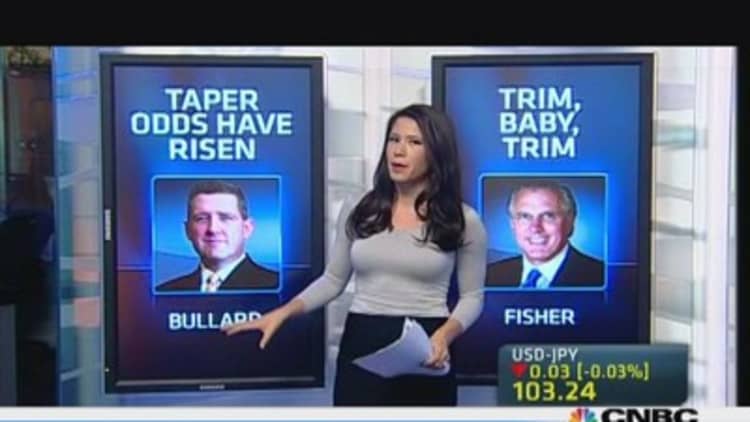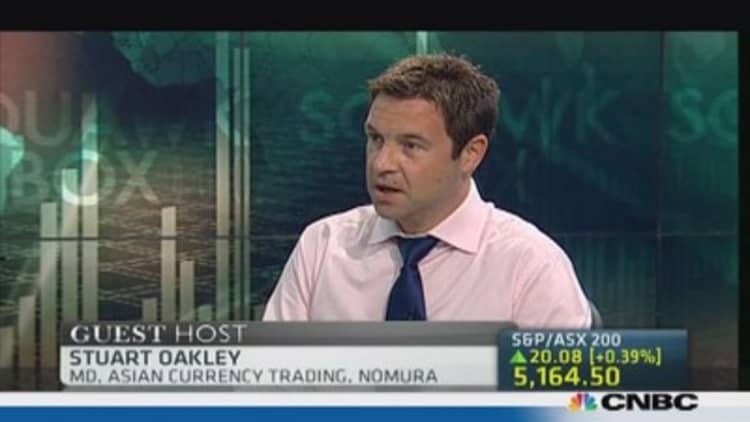As the Federal Reserve prepares to withdraw its quantitative easing measures, the path to higher interest rates is unlikely to be smooth.
Yet, while most traders don't foresee a big spike, yields could still touch uncomfortably high levels in 2014 as the market adjusts.
The ripple effect of higher rates has already been felt in the economy, with a jump in mortgage rates, but yields on the longer end of the curve are still expected to stay way below the norm in the coming year.
The National Association of Business Economists predicted Monday that short-term rates are expected to stay at current levels, but that the yield curve will steepen and the 10-year could rise to 3.25 percent by year end.
(Read more: Stock market stages modest climb)

BlackRock's Jeffery Rosenberg, chief investment strategist for fixed income, sees the short end staying at current levels but he expects the 10-year yield to rise by a half percentage point next year. From its current level of 2.85 percent, that would put the yield at 3.35 percent.
Now, after Friday's strong jobs report, the market expects the Fed to step back from its quantitative easing program in the next couple of months, with some forecasts for tapering as early as next week's policy meeting.
(Read more: Here it comes - the December taper)
Due to heightened expectations for a near-term Fed tapering, markets are keenly focused on U.S. bond yields. There are three Treasury auctions of interest this week, starting with $30 billion in 3-year notes Tuesday. But traders are especially watching to see if yields move ahead of Wednesday's auction of $21 billion in 10-years—and Thursday's $13 billion in 30-year bonds.
(Read more: Global economy might be comeback story of 2014)
"The forecast for rates is an inflection point for Fed policy. We're going to move away from quantitative easing and we're going to move ahead to forward guidance," said Rosenberg.
The Fed is emphasizing that it will keep the Fed funds rate at zero for a long time to come, and the market does not expect a rate hike until 2015.
"I think the key issue in the outlook for 2014 isn't necessarily understanding the shift but whether they are going to be successful at it. They are trying to move the main tool of monetary policy away from purchases and on to promises," Rosenberg said.
The 10-year touched a high of 3 percent this year when the market was expecting the Fed to begin tapering back its $85-billion-a-month bond-purchase program in September. That level was spooky for stocks, which are expected to be more volatile in the coming year as rates move higher.
(Read more: Investor sentiment hints at Santa Claus rally)
Morgan Stanley strategists expect the 10-year yield to rise to just below 3.5 percent, while Barclays strategists, in a global rate forecast, said 10-year yields could finish 2014 at 3.5 percent.

"First, the magnitude of the move next year should be lower than in 2013," the Barclays strategists wrote in a note. "Second, data are likely to be stronger in most developed countries next year and should be a large part of why rates rise. Most importantly, rates should move higher despite significant obstacles. In the U.S., the Fed will likely provide forward guidance to prevent rates from rising too far when it tapers."
Barclays strategists say they now expect the Fed to begin to slow its bond purchases in March. "After years of plumbing new lows in yields, the U.S. bond market finally started selling off in earnest this year. The catalyst has not been stronger GDP [gross domestic product] numbers, which remain stuck around 2 percent. Instead, there are two inter-related reasons," they noted. "One is the rapid improvement in the labor market even in the face of mediocre GDP growth. The other is the Fed emphasizing that labor market improvements will play a larger role in driving monetary policy."
(Read more: Why 2014 could be a'record year' for stock listings)
Rosenberg said it's possible the 10-year yield could overshoot, but it would likely to be contained based on his view.
"The core of my outlook is the dependency of the economy on financial market conditions, so this is exactly what the Fed has been talking about since the 'taper tantrum' of July," he said. "Financial market conditions need to remain easy to support the economic recovery. 'Financial markets conditions' is code word for stocks, bonds and importantly mortgage rates."
Rosenberg said if the bond market overshoots, and rates rise too high, too fast. "That's only going to sow the seeds of its own demise," he said.
"What has supported the economy are three main things—interest rate sensitive spending; it's housing and it's wealth effect induced spending," he said. "They're all highly dependent on easy financial market conditions." Rosenberg said there are limits to how high interest rates can go in an economy dependent on this type of growth.
Traders have also said a quick jump in yields could create a selloff in stocks, which could act as a catalyst to bring rates back down.
(Read more: Cashin warns: This could spark 'outright selling')
There is debate over whether the motors for the economy can change in the coming year. "We're waiting to see business spending. We're waiting to see cap ex. We're waiting to see income growth. These are missing in the economy," Rosenberg said.
Rosenberg said he expects the Fed to wait for more data before tapering its bond buying, so the December meeting is not a likely time for it to act.
As for the timing of the Fed's move to taper bond buying, in a survey of primary dealers Reuters found that most expect the wind down of bond purchases to begin in January or March. Of 18 of the 21 dealers surveyed, eight expect tapering to begin in March and five expect it in January. There were four that said it could start in December or January.
—By CNBC's Patti Domm. Follow here on Twitter @pattidomm.


